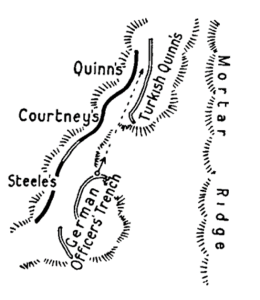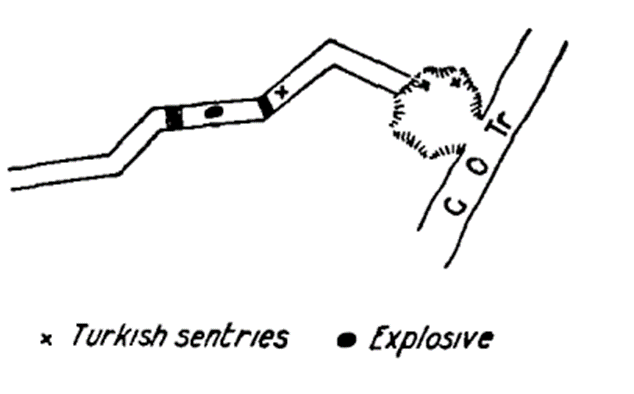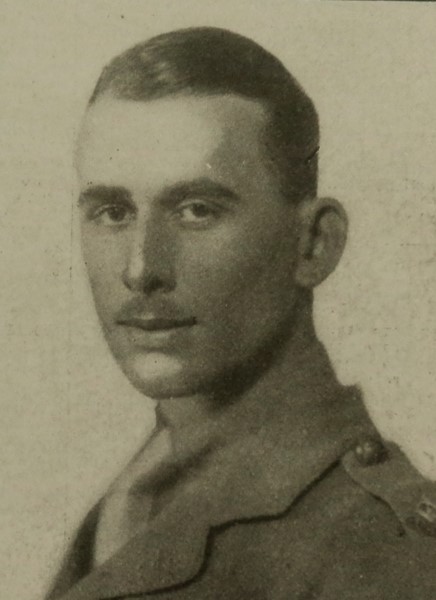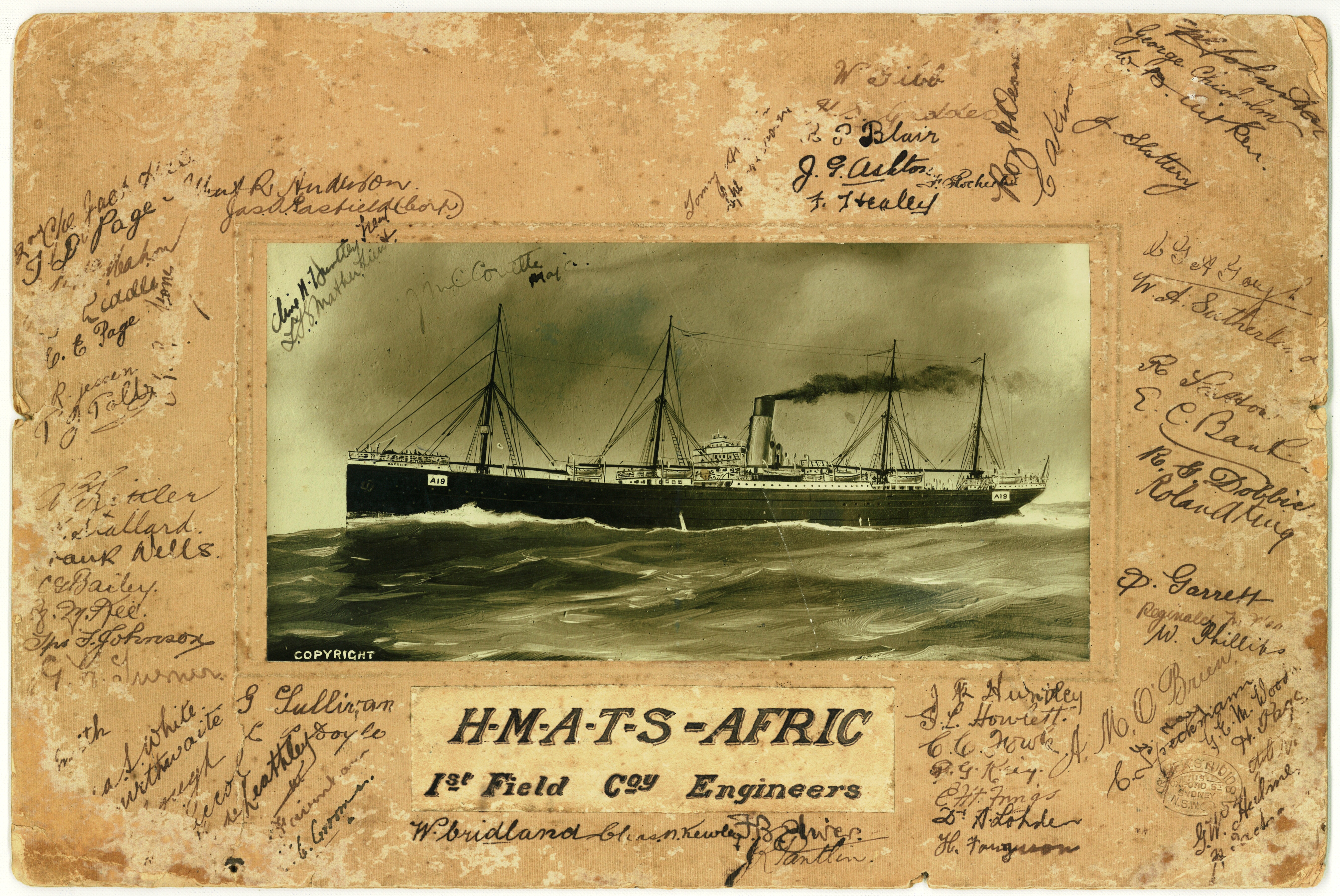Gallipoli has many landmarks and place names spread across its unforgiving terrain. Many were named after famous military officers, such as Plugge’s Plateau, named after Lieutenant Colonel Arthur Plugge, commanding officer of the Auckland Battalion, after the Anzacs captured its position.
Other place names include Monash Valley, named after Brigadier Monash, and strategic points like Quinn’s Post, the most advanced post of the Anzac line, named after Major Hugh Quinn of the 15th Battalion AIF, who was killed defending the post.
Some place names became famous for their battles, such as Lone Pine, where seven Victoria Crosses were awarded to Australians. One battle zone with one of the most notorious place names was the ‘German Officers Trench’ (GOT), so-called because a German Officer was reportedly sighted there early in the campaign. The GOT, as it was called, was a strategic point for the Turks and would become as deadly a location as Lone Pine.
In the 1st Field Co. Eng. unit diaries during the Gallipoli campaign, there are only a few references to particular men in the company; however, there is a rare moment when on June 14th, 1915, 228 William Davis Cohen and fellow sapper 58 Percy Hirst are both mentioned as being actively involved in testing the firing line of the enemy whilst new saps and tunnels were being navigated, both of them going out nightly against constant enemy fire and managing to secure plans for Turkish trenches for their commanding officer Lieut. Richard John Dyer.
A few days earlier, Lieutenant Richard Dyer and other members from the No. 2 section of the 1st Field Co. Engineers had started preparing mines for an underground attack near enemy lines at what was known as the ‘German Officers Trench’.
Tunnel warfare had begun, and Australian war historian Charles Bean’s chapter on the German Officers’ Trench gives a detailed account of the complexities of this new stage of warfare. Bean also gives a rare account of the involvement of the 1st Field Co. Engineers in this chapter and, in particular, the role of Lieut. Richard Dyer and his place in this fascinating part of Gallipoli history.
Bean’s account describes how Lieutenant Dyer, in an attempt to break a tunnelling stalemate, ‘attempted a novel method of ejecting the enemy’. The Anzacs and Turks occupied the same tunnel that branched off from the German Officers’ trench towards Steele’s Post. The Australian barrier in the tunnel was a short distance from the Turks’ position and guarded by a loan sentry. Naturally, neither side could advance, and neither would abandon their position.

Charles Beans diagram of the GOT – German Officers’ trench in relation to Steeles Post
It was reported that Dyer managed to put out over the top of the barrier and lower to the ground a 25lb charge of gun cotton explosives with electric wires placed near the Turkish position of the tunnel. The Engineers added more dirt to the barrier, barricading themselves behind ten feet of dirt. On July 9th, Dyer detonated the charge, which made a massive explosion, killing three Turks, collapsing the Turk’s side of the tunnel and creating a vast crater to be known thereafter as ‘Dyers Crater’.
The Diagrams below from the Charles Beans chapter show the evolution of the tunnel emerging from GOT—The German Officers’ Trench and its tunnel approach towards Steele’s Post, and then the new crater formed by Dyer’s explosion, which destroyed the tunnel.



The young Lieutenant was later recognised for his extraordinary work at Gallipoli, mentioned in despatches, and also bestowed The Croix d’ officer -Legion of Honour -the citation read as follows.
“Coolness and pluck during the landing on April 25, also for general work in places of danger for several days afterwards. When stationed at German Officers’ Trench for untiring efforts in mining and conspicuous acts of gallantry when coming in contact with the enemy underground. In no case did the enemy ever cause any damage to our own galleries and no loss of life was incurred.”
A more personal account of the assault on the GOT was written in the diary of sapper 139 Philip Owen Ayton and later included in a book published by his family, titled “A Hell Of A Time’. Phillip was an original in Section No. 2 under the command of Richard Dyer. Phil Ayton had just returned to Gallipoli from Alexandria after recovering from being wounded in the leg by shrapnel.
Phil described how he ‘was glad to be back with the boys’ and rejoined section No. 2 on the firing line only 50 yards away from the GOT. He described how the men had made a network of galleries, tunnels and saps in what was called ‘No Mans Land’. It was while Phil took up position in one of the saps with fellow original 122 Cpl John “Jack” Gough and they could clearly hear the Turks digging towards them. Phil explained that ‘it was a case of who should get in first with a shot’.
Lieut Dyer decided that it was the Anzacs who would strike first. Phil Ayton gave a detailed account of preparing the heavy explosive charge and how difficult the job was building the barricades in pitch dark with limited oxygen. When the job was complete, Lieut Dyer didn’t hesitate to set off the terrific explosion. Phil Ayton described how, at about 10 o’clock at night, ‘the whole hill seemed to shake a foot.’The night air was filled with flying earth and flame, and the explosion wrecked about 25 yards of the Turks’ trench, ultimately forming a giant crater.
When Richard John Dyer left his mark on the landscape of Gallipoli, he was just 21. In defiance of his age and rank, Richard Dyer would continue to demonstrate extraordinary leadership in the field of action for the entirety of the Great War. A natural-born leader, his capabilities and military maturity would set him apart from others. By December of the following year, he was the (O.C) Officer Commanding the entire 1st Field Company Engineers and facing down the Germans on the Western Front.
His full WW1 story is astonishing, and one cannot help but be awestruck by such a young man and his extraordinary achievements during the war.
To read more about Richard Dyer, please follow the link to his Biography page. link Richard John Dyer
Sources:
AWM, Charles Bean Anzac Volumes, ‘A Hell of a Time’ – Philip Owen Ayton

















